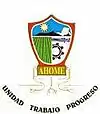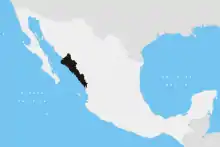Ahome
Ahome (Spanish pronunciation: [aˈome]) is a municipality on the coast of the Gulf of California in the northwestern part of the Mexican state of Sinaloa; it is adjacent to the southern border of Sonora state. It reported 388,344 inhabitants in the 2005 census. Ahome (population 10,840) is also the name of the second-largest community in the municipality. The municipal seat is the port city of Los Mochis, its largest community. It is the third most important municipality in the state of Sinaloa, and is a commercial corridor to the northwest of the country. It is situated on the Pacific coastal plain, at the entrance of the Gulf of California and lies in the heart of a rich agricultural region, Fort Valley. It stands at 25°33′50″N 108°46′00″W.
Ahome Municipality
Municipio de Ahome | |
|---|---|
 Coat of arms | |
 Location of the municipality in Sinaloa | |
| Country | |
| State | |
| Seat | Los Mochis |
| No. of Sindicaturas | 7 |
| Foundation | 1917 |
| Government | |
| • Municipal president | Manuel Guillermo Moreno |
| Area | |
| • Total | 4,342.89 km2 (1,676.80 sq mi) |
| Population (2010) | |
| • Total | 416,299[1] |
| Time zone | UTC-7 (Mountain Standard Time) |
| • Summer (DST) | UTC-6 (Mountain Daylight Time) |
| Website | Ahome government page |
Major communities
- Los Mochis (Municipal seat)
- Ahome
- Higuera de Zaragoza
- Topolobampo
- San Miguel Zapotitlán
Political subdivision
Ahome Municipality is subdivided in 7 sindicaturas:
- Central-Mochis
- Topolobampo
- Ahome
- Higuera de Zaragoza
- El Guayabo
- San Miguel
- El Carrizo
History
- 1605 - Foundation of the town of Ahome, with the arrival of Jesuit missionaries led by Father Pérez de Ribas.
- 1851 - Year of cholera, when the disease claims numerous lives in the region.
- 1880 - Installation of a sugar refinery, a fundamental pillar of the future city.
- 1901 - Opening of the Kansas City Mexico & Oriente Railway company in Topolobampo.
- 1903 Foundation of Los Mochis.
- 1904 - Creation of the town of Ahome la Junta Separatista (Separatist Committee), which seeks separation from the municipality of El Fuerte (the Fort) and the creation of Ahome.
- 1914 - Felipe Bachomo takes la Villa de Ahome (Village of Ahome) by violent force.
- 1917 - La Villa de Ahome is designated municipal seat of the new municipality.
- 1935 - The city council changes the municipal seat to Los Mochis.
Municipal presidents
- 1948 - 1950: Francisco Ceballos - One of the best municipal presidents due to his contributions to the municipality, including the highway between Los Mochis and Ahome and between Los Mochis and Topolobampo
- 1951 - 1953: Samuel C. Castro
- 1954 - 1956: Armando Guerrero
- 1947 - 1959: Miguel León López
- 1960 - 1962: Antonio López Bojórquez
- 1963 - 1965: Alfonso Calderón Velarde
- 1966 - 1968: Canuto Ibarra Guerrero
- 1969 - 1971: Ernesto Ortegón
- 1972 - 1974: Nicanor Villareal
- 1975 - 1977: Oscar Monzón
- 1978 - 1980: Oscar Aguilar Pereira
- 1981 - 1983: Jaime Ibarra
- 1984 - 1986: Felipe Moreno Rosales
- 1987 - 1989: Ernesto Álvarez Nolasco
- 1990 - 1992: Ramón Ignacio Rodrigo Castro
- 1993 - 1995: Federico Careaga
- 1996 - 1998: Francisco López Brito
- 1999 - 2001: Esteban Valenzuela García
- 2002 - 2004: Mario López Valdez
- 2005 - 2007: Policarpo Infante Fierro
- 2008 - 2010: Esteban Valenzuela García
Prominent Persons
- 1847 - 1916: Albert K. Owen - Born in Chester, Pennsylvania; civil engineer who came to the region to construct the Norfolk-Topolobampo Railroad, where he formed a settlement and dreamed of constructing a utopian city.
- 1865 - 1937: Benjamin F. Johnston - Born in Sharon, PA; one of the founders of the municipal lands and one of the principal industrialists who founded the Aguila Refining Company. From a small settlement of tenant farmers, he erected the city of Los Mochis, which in 1903 began to develop into a North American city in terms of urbanity.
- 1874 - 1948: Candelario Ochoa - Great professor who was none other than the town's first teacher, as well as founder and director of various schools.
- 1883 - 1916: Felipe Bachomo - Born in Jahuara, an indigenous leader native to the valley that fought to the death against the "yoris" (whites) who were seeking to take possession of the land belonging to the "indios" (Native Americans) of the region.
- 1887 - 1953: Marcario Gaxiola Urias - Born in Bacamacari; great soldier who fought against the troops of Victoriano Huerta as commander of Maderista forces; he took the plaza of Los Mochis on April 5, 1913.
- 1894 - 1951: Zacarías Ochoa - Great landowner and Porfirista displaced by Benjamin F. Johnson's sugar refinery.
- 1896 - 1977: Conrado Espinoza - In 1934 opened the first secondary school from the north of Sinaloa and the south of Sonora where 50% of the student body was made up of peasants; from this first school arose the present-day Centro Escolar del Noroeste (Scholar Center of the Northwest), a prestigious school today. He also donated facilities to the present-day Casa de la Cultura (House of Culture) which bears his name in the city of Los Mochis.
- 1909 - 1975: Canuto Ibarra Guerrero - Prominent businessman who founded an unprecedented conglomerate of businesses that ranged from commerce, agriculture, real estate, and services. Was later involved in politics and became mayor of Los Mochis, and died prematurely in Culiacan, Sinaloa.
- 1913 - 1990: Alfonso Calderón Velarde - Founder, in 1934, of la Unión de Obreros y Campesinos del Norte de Sinaloa (the Union of Workers and Laborers of the North of Sinaloa); municipal president and state governor; fought for the establishment of eight-hour workdays and for the signing of a collective agreement between United Sugar and its employees.
Climate
The climate is mildly hot and humid, hardly modified by rainfall. Studies have established the average annual temperature to be 33°C (91.4°F). In the last twenty-eight years, the lowest recorded temperature was 5°C (41°F) and the highest was 43°C (109.4°F), the hottest months being from July to October and the coolest from November to February. In the period of reference, rainfall averaged 302.2 mm (11.9 inches) annually, with the rainiest months being from July to October. The prevailing winds in the region are oriented in a southwesterly direction with an approximate speed of one meter per second (2.23 mph). Relative humidity averages between 65 and 75%.
References
- "Main results by locality 2010". INEGI. 2010.
- Link to tables of population data from Census of 2005 INEGI: Instituto Nacional de Estadística, Geografía e Informática
- Sinaloa Enciclopedia de los Municipios de México
